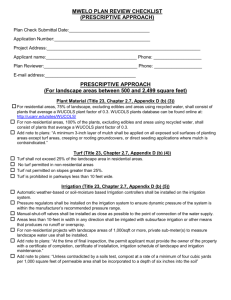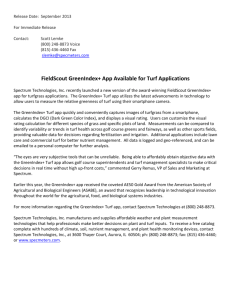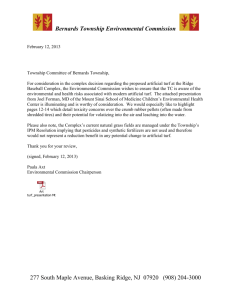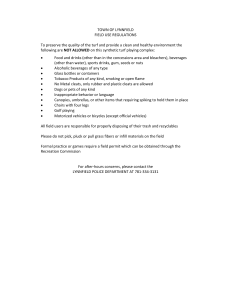4277 version 6 10-Sep-13 1 of 6 SPORTS TURF CONSTRUCTION
advertisement
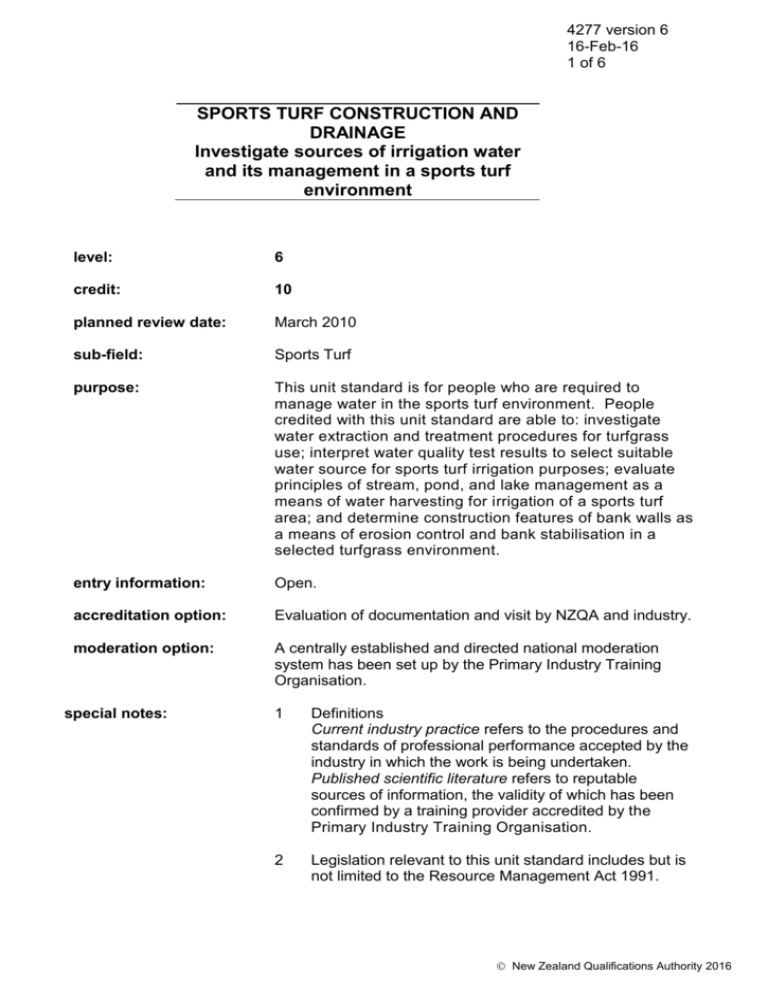
4277 version 6 16-Feb-16 1 of 6 SPORTS TURF CONSTRUCTION AND DRAINAGE Investigate sources of irrigation water and its management in a sports turf environment level: 6 credit: 10 planned review date: March 2010 sub-field: Sports Turf purpose: This unit standard is for people who are required to manage water in the sports turf environment. People credited with this unit standard are able to: investigate water extraction and treatment procedures for turfgrass use; interpret water quality test results to select suitable water source for sports turf irrigation purposes; evaluate principles of stream, pond, and lake management as a means of water harvesting for irrigation of a sports turf area; and determine construction features of bank walls as a means of erosion control and bank stabilisation in a selected turfgrass environment. entry information: Open. accreditation option: Evaluation of documentation and visit by NZQA and industry. moderation option: A centrally established and directed national moderation system has been set up by the Primary Industry Training Organisation. special notes: 1 Definitions Current industry practice refers to the procedures and standards of professional performance accepted by the industry in which the work is being undertaken. Published scientific literature refers to reputable sources of information, the validity of which has been confirmed by a training provider accredited by the Primary Industry Training Organisation. 2 Legislation relevant to this unit standard includes but is not limited to the Resource Management Act 1991. New Zealand Qualifications Authority 2016 4277 version 6 16-Feb-16 2 of 6 SPORTS TURF CONSTRUCTION AND DRAINAGE Investigate sources of irrigation water and its management in a sports turf environment Elements and Performance Criteria element 1 Investigate water extraction and treatment procedures for turfgrass use. performance criteria 1.1 Publicly-available empirical information is used to identify major sources of water supply in a selected region. Range: 1.2 Investigation identifies sources of ground water and the implications of each of those sources for bore hole extraction. Range: 1.3 sources of publicly-available empirical information may include but are not limited to – New Zealand Meteorological Service, Regional Councils, Ministry for the Environment; sources of water supply to be assessed may include but are not limited to – precipitation, streams, rivers, lakes, ground water, mains supply, recycled water. sources of ground water may include but are not limited to – confined aquifer, unconfined aquifer, water table, spring, flowing artesian well, water table well, piezometric pressure, non-flowing artesian well, perched water table, intermittent spring. Investigation explains legislative control and cost factors which influence extraction and storage procedures for different water sources. Range: legislative control factors include but are not limited to – Resource Management Act, extraction permits; cost factors may include but are not limited to – surface storage, tank storage, bore holes. New Zealand Qualifications Authority 2016 4277 version 6 16-Feb-16 3 of 6 SPORTS TURF CONSTRUCTION AND DRAINAGE Investigate sources of irrigation water and its management in a sports turf environment 1.4 Analysis of the treatment process elements for potable water identifies minimum requirements for recycled water used on turfgrass areas. Range: 1.5 treatment process elements may include but are not limited to – storage, screening, aeration, coagulation, flocculation, clarification, filtration, pH adjustment, disinfection, softening. Analysis of the factors involved in using treated water identifies the implications of its use on turfgrass areas. Range: factors may include but are not limited to – treatment procedures, application mechanisms, transportation logistics, user reaction, cost, adverse and beneficial soil and turf effects, human health. element 2 Interpret water quality test results to select suitable water source for sports turf irrigation purposes. performance criteria 2.1 Interpretation of water quality test results identifies the physical, chemical, and biological characteristics of water quality relevant to turfgrass growth. Range: physical, chemical and biological characteristics explained will include but are not limited to – total soluble salts, electrical conductivity, sodium hazard, pH, osmotic pressure, toxic ion levels, bicarbonate, soil factors, colour, hardness, turbidity, odour, biological oxygen demand, faecal coli concentration. 2.2 Interpretation of results determines if chemical, physical, and biological characteristics of water quality conform to turfgrass growth requirements identified in published scientific literature. 2.3 Interpretation of results identifies the level of tolerance warm season turf grasses and cool season turf grasses will have to the tested water quality. New Zealand Qualifications Authority 2016 4277 version 6 16-Feb-16 4 of 6 SPORTS TURF CONSTRUCTION AND DRAINAGE Investigate sources of irrigation water and its management in a sports turf environment 2.4 Interpretation of results identifies how the water quality identified will influence soil characteristics. Range: 2.5 soil characteristics may include but are not limited to – sodium and/or salinity hazard, structural stability, leaching ability, soil texture, climatic zone. Documentation of result interpretation provides justification for irrigation water source options selected. element 3 Evaluate principles of stream, pond, and lake management as a means of water harvesting for irrigation of a sports turf area. performance criteria 3.1 Evaluation of key factors identifies the suitability of clay soil lining systems and synthetic lining systems. Range: 3.2 Evaluation of key factors identifies effects of periodic flooding on turfgrass areas. Range: 3.3 key factors may include but are not limited to – irrigation demand, catchment size, catchment field, catchment water source, types of dam, climatic data, abstraction rate, storage to excavation ratio. key factors may include but are not limited to – erosion, deposition of soil, salt and debris, turfgrass susceptibility, scale, algae, renovation procedures. Evaluation of methods of algae and odour control in ponds and lakes provides a comparison of mode of action and efficacy of the methods considered. Range: methods may include but are not limited to – fountains, air injection, waterfalls and streams, constructed wetlands, sunlight and nutrient levels, filters, chemical amendments. New Zealand Qualifications Authority 2016 4277 version 6 16-Feb-16 5 of 6 SPORTS TURF CONSTRUCTION AND DRAINAGE Investigate sources of irrigation water and its management in a sports turf environment 3.4 Analysis of information prepared for a nominated sports turf area is used to develop a suitable catchment model for water harvesting for that turf area. element 4 Determine construction features of bank walls as means of erosion control and stabilisation in a selected turfgrass environment. performance criteria 4.1 Analysis of artificial and natural stabilising techniques identifies the nature of the material, its application and its mode of action for each technique. Range: 4.2 Analysis of site conditions is used to determine the choice of erosion control and stabilising technique to be used. Range: 4.3 site conditions include but are not limited to – water flow intensity, water flow duration, steepness and length of slope, soil type, watershed area, precipitation intensity and duration. Assessment of soil suitability for embankment building is undertaken in accordance with current industry practice. Range: 4.4 stabilising techniques include but are not limited to – mulching, hydroseeding, geotextiles, vegetated concrete block systems, turf reinforcement mats, revegetation mats, vegetated geocellular containment systems, gabions, concrete, asphalt, riprap, concretefilled geocellular containment systems. assessment will include application of funnel test, cup test, dispersion tests, dilatance test. Descriptions of procedures for construction of bank walls for water harvesting or storage purposes are in accordance with current industry practice. Range: procedures may include but are not limited to – establishing bank slopes and batters, clay blanket method, key trench, impervious core, compaction process, topsoil stripping, topsoil stockpiling, excavation process, earthworks calculations. New Zealand Qualifications Authority 2016 4277 version 6 16-Feb-16 6 of 6 SPORTS TURF CONSTRUCTION AND DRAINAGE Investigate sources of irrigation water and its management in a sports turf environment Comments on this unit standard Please contact Primary Industry Training Organisation standards@primaryito.ac.nz if you wish to suggest changes to the content of this unit standard. Please Note Providers must be accredited by the Qualifications Authority or a delegated interinstitutional body before they can register credits from assessment against unit standards or deliver courses of study leading to that assessment. Industry Training Organisations must be accredited by the Qualifications Authority before they can register credits from assessment against unit standards. Accredited providers and Industry Training Organisations assessing against unit standards must engage with the moderation system that applies to those standards. Accreditation requirements and an outline of the moderation system that applies to this standard are outlined in the Accreditation and Moderation Action Plan (AMAP). The AMAP also includes useful information about special requirements for providers wishing to develop education and training programmes, such as minimum qualifications for tutors and assessors, and special resource requirements. This unit standard is covered by AMAP 0037 which can be accessed at http://www.nzqa.govt.nz/site/framework/search.html. New Zealand Qualifications Authority 2016
